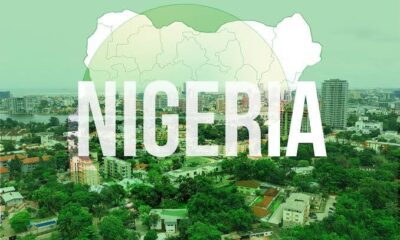National Issues
The Installation Of Telecommunications Masts And Towers In Nigeria; The Precautionary Approach -By Chinaza Eneh

INTRODUCTION
Since the advent of GSM (Global system for Mobile Communication) and mobile communication in Nigeria, we have experienced quite a thrive in almost every sector of the Nigerian Economy as a result of easy and improved communication, thus facilitating quick access between and among people who are thousands of miles apart from each other. This has globally impacted the Economy of the world at large.
However, it seems that it has become a “necessary evil”, as it portends some negative impacts for the Environment and the citizenry at large. This is because the wide-spread use of GSM phones, technological and communication devices has led to the springing forth of towers and masts almost at every corner of the country, which has further led to the increase in the fears and anxieties of the public as regards the adverse effects of these to their health, safety and the environment at large. These masts could be seen very close to residential houses, churches, schools etc. in fact, in one case at Ughelli in 2014, a mast fell on top of a church on a Sunday, killing a man who was dedicating his child, and injured many. This and so many instances has sky-rocketed the fears of the public as to whether the adverse effects of this “necessary evil” can be allayed. This and more have spurred me to write this brief article.
WHAT DOES THE LAW HAVE TO SAY?
The Constitution of the Federal Republic of Nigeria , vests the National Assembly with power to make laws on any matter contained in the Exclusive Legislative Lists to the exclusion of the states. Telecommunications is covered under items 46, 66 & 68 of part 1 in the 2nd Schedule of the Exclusive lists of the Constitution. Thus, pursuant to this power, the National Assembly has passed some laws that have relevance with protection of the Environment, particularly the habitants against Telecommunications Installation hazards. In this brief discourse, we shall be examining few of these laws.
• THE NIGERIAN COMMUNICATIONS ACT, 2003 (NCA, 2003)
This is the regulatory framework of the Telecommunications sector, and just as the Constitution is the grund norm, the Nigerian Communications Act, 2003 (hereinafter referred to as NCA, 2003) can be referred to as same, as long as Telecommunications matters is concerned. This is the primary regulatory framework that aids easy running of the affairs of the Telecommunications industry in the Country . The Act goes a long way to stipulate provisions that will aid the growth and development of the Telecommunications sector, and also extends to the protection of the Environment in the course of Installation of masts and towers.
The law tends to protect the Environment and its inhabitants from the negative and adverse impacts of the activities of the telecommunications service providers especially during the installation of masts and towers or after the installation thereof by providing that “all reasonable steps to ensure that the facilities cause as little detriment and inconvenience as possible to the public must be taken” . This provision helps to checkmate their activities before and during installation of their masts and towers to ensure that detriments and inconvenience caused during same is reduced to the barest minimum.
Further, the commission is saddled with the onerous responsibility and task of carrying out approval tests on communications equipment, and to issue certificates on the basis of technical specifications and standards prescribed from time to time . This is to prevent the use of Sub-standard towers and masts which do not meet the approval of the commission, and is likely to serve as a threat to the lives of the public. The law also mandates licensees to take reasonable steps to act in accordance with good engineering practice; protect the safety of persons and properties and protect the Environment .
The above provisions were inserted to ensure that the activities of telecommunications operators in the disbursement of their services to the public should conform to internationally recognized principle of precautionary approach which ensures the protection of the Environment and the public from harm occasioned by the installation of masts and towers.
• THE GUIDELINES ON TECHNICAL SPECIFICATIONS FOR THE INSTALLATION OF MASTS AND TOWERS, 2009
The NCC (Nigerian Communications Commission) has been charged with the power to make regulations and guidelines , it is in exercising this power conferred on it that it issued the Guidelines on technical specifications for the installation of masts and towers in April, 2009 (hereinafter referred to as 2009 Guidelines). This Guideline provides precautionary steps and approach to follow in other to prevent hazardous occurrences that will affect the environment or public safety. The essence of the Guideline basically, with special regards to the siting of telecommunication masts and towers is to minimize their number, protect and promote public safety and navigate adverse visual impacts on the community. To reduce the visual impact of towers and antennas and to facilitate smooth provision of telecommunication service to the public, standards to be adhered to by telecommunication service providers, operators, designers, fabricators and installers of telecommunication towers towards ensuring Environmental safety and sound engineering practices is provided for in the Guideline . This is to ensure that due diligence and all necessary care is taken and followed by telecommunication service providers to prevent Environmental and health hazards.
The 2009 Guideline further stipulates that in siting of masts and towers, telecommunication service providers shall take cognizance of provisions of the NCA (Nigerian Communications Act) and be guided by the provisions of the Collocation and Infrastructure Sharing Guidelines of the Commission . This is because the Act provides for strict measures that have to be put in place to ensure the protection of the Environment and the public. It is worthy of note that Collocation and Infrastructure Sharing is one of the ways by which the Environment is protected from the adverse impacts of Telecommunication installations. This is because in the operators desire to ensure quality of installations. This is because in the operators desire to ensure quality of service to all their subscribers and subsequent rollout of towers and masts, there is bound to be proliferation of masts/towers in a particular vicinity. In a bid to tow the line of precaution, the Guideline encourages the use of stealth camouflage designed masts in other to mitigate adverse visual impacts of towers and antennas structure on the community. The Guideline further directs the operators to conform to the standards on radio frequency. This is because exposure to very high radio frequency intensities can result in heating of biological tissue and an increase in body temperature. Tissue damage in humans could occur during exposure to high radio frequency levels because of the body’s inability to cope with or dissipate the excessive heat that could be generated; this basically leads to a reduction in the life span of a person exposed to such.
Further, with regards to masts and towers to be installed within residential areas, they must not be more than 25 meters except it is approved by the commission. Albeit, where it is approved, it must conform to the 5 meter set back from the nearest demised premises, excluding the fence . It is pertinent however, in this discourse to point out conditions under which approval can be given by the commission to an operator to install a tower or mast in an area designated residential; where the installation:
(a) Will not be detrimental to public health, safety or general welfare
(b) Will not have negative effect on the neighborhood
(c) Is in conformity with the plan of the particular area and the general plan of the community
(d) Will not impair compliance with any other applicable laws or guidelines
To also avoid collision or aircraft mishap, the Guideline further provides that the towers and masts must be illuminated only as required by NAMA (Nigerian Airspace Management Authority) or ICAO (International Civil Aviation Organization), and also that security lighting around the base of a tower must be shielded so that no light is directed towards adjacent Properties or rights-of-way .
Compliance with these Guidelines goes a long way to ensure that the installation of towers or masts does not in any way lead to the causation of unnecessary harm to the Environment or any member of the public thereof.
• NATIONAL ENVIRONMENTAL STANDARDS AND REGULATIONS ENFORCEMENT AGENCY (ESTABLISHMENT) ACT, 2007
This Act established NESREA as Nigeria’s primary Environmental protection Agency . The Act empowers NESREA to enforce compliance with laws, guidelines, policies and standards on Environmental matters; enforce compliance with the provisions of International Agreement protocols, conventions and treaties on Environmental pollution . To prevent Environmental hazards like Air, Noise and Water pollution, land degradation or discharge of hazardous waste, which may usually result from any private or Industrial activity including telecommunication industries, the Act empowers the agency to make regulations setting specifications and standards for the protection and enhancement of the quality of Nigeria’s environmental resources, so as to promote the public health or welfare and the natural development and productive capacity of the nation’s habitat . It is to this end, and in furtherance of these purposes that NESREA made and issued the 2011 NESREA Regulations.
This would therefore lead us into examining some provisions of the regulation that help to ensure that due diligence are employed by telecommunication service providers during installation of masts or towers.
• NATIONAL ENVIRONMENTAL (STANDARD FOR TELECOMMUNICATIONS AND BROADCAST FACILITIES) REGULATIONS, 2011
This is a product of the power conferred on the minister of Environment, Urban and Regional development in other to give full meaning and effect to the functions of NESREA as an agency. Thus, whereas the 2009 Guidelines relates directly to the telecommunication sector, this regulation regulates issues that directly affect the environment as a result of the activities of telecommunication service providers/operators. It is further necessary to point out that the main thrust of this Regulation is to enforce Environmental laws, protect environmental and human health, ensure safety and general welfare, eliminate and minimize public and private losses due to activities of the telecommunication industry .
It is provided that the installation of towers and masts by telecom service providers or operators must not be detrimental to environmental protection, public health, safety or general welfare . This means that any slightest evidence that a tower or mast is detrimental to the environment or is a health hazard to those living around, it is an infraction and thus must be removed with immediate effect. Also, the regulation, like the 2009 Guidelines, provides for a minimum set back of 10 meters that must be maintained by any tower or mast. This set back is to ensure that these masts or towers do not serve as a means of Nuisance to those living around it. It is pertinent to note that the issue of setback was a serious issue between the NESREA and NCC(given the Efab Estate Saga ), however the issue has been resolved, and by virtue of the Communiqué issued at the end of the meeting, both agencies have agreed to a standard minimum setback of 7.5 meters .
Through a more careful perusal through the Regulation, it is stipulated that any abandoned telecommunication or broadcasting base station and towers or masts shall not be allowed to pose threats to the environment, human health and safety . This is because it is prone to become/pose a danger and threat to human life, and can even be a “good” site for hoodlums, social misfits and unscrupulous elements. It is also mandatory that any telecommunication service operator or provider who ceases operation must restore the site to its natural state within six months . This is necessary in other to conform to the Environmental standards, given recourse to the provisions of the Environmental Impact Assessment Act. The Regulation further provides that for routine Inspection and monitoring of all telecommunication and broadcasting facilities to determine compliance with these Regulations . This is to ensure that each telecommunication service provider/operator operates under the provisions of this Regulation; some of these provisions which include Generator setback, quality of generator set to be used at base stations, the kind of power source that is encouraged (environmental friendly) example- wind, solar, hydro(water) etc.
CONCLUSION
It is thus not in doubt that for telecommunication service providers and operators to continue to provide quality service to the public, there is a dire need for the expansion and multiplicity of telecommunication installations. However, the yearning for quality service by the public coupled with the need for more installations, and given the hazardous effects, the public is left at a dilemma as to whether to pursue quality service at the expense of its attendant hazard or to pursue this “necessary evil”. It is this dilemma that has not only spurred me to research and write, but also through this medium sensitize the public about the precautionary approach needed before, during and after the installation of telecommunication masts or towers by service providers/operators.
In this onerous task of examining and x-raying this, it is paramount to conclude by saying that the fate of our environment, public safety and health as regards the telecommunication sector depends on how willing, zealous and hell-bent we are on advocating and standing on these provisions to ensure that they are given teeth to “bite”, and they don’t end up merely as toothless bull dogs who can bark loudly, but can never bite.









